Great Russell Fire

The historical plaque commemorating the Great Russell Fire was added to the Historical Plaque Program in 2019, in partnership with the Russell and District Historical Society.
This plaque is located at 1122 Concession Street, Russell.
How Did the Great Russell Fire Start?
On June 6, 1915, Bernard Murray left his house at 220 Mill Street in Russell to go to church in the village of Metcalfe. About 9 AM a fire started in his tinsmith shop and spread very rapidly west to the house next door. The wind quickly changed and the fire spread east toward Concession St., burning all the buildings as it went. Neighbours quickly organized bucket brigades, but it soon became evident the fire was beyond their control. By 10 AM, telephone calls for help were sent out to Metcalfe and Ottawa.
The Ottawa Fire Department, in cooperation with the New York Central Railway, responded with truly remarkable speed. The Silsby steam pumper #859, an Ottawa fire crew, and other firefighting equipment were loaded on a flat car and rushed to Russell on a special train. The train engineer is said to have made the fastest trip ever from Ottawa to Russell and severely reprimanded by his superiors for the risks he had taken.
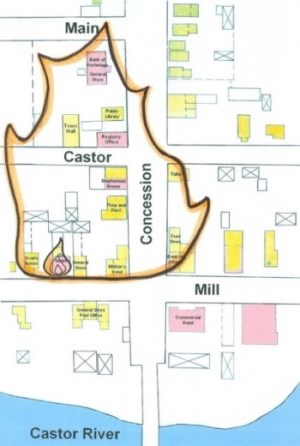
A little after 12 noon the train arrived at the Russell station where a team of horses were waiting. The pumper was quickly unloaded and rushed to a suitable spot on the Castor River. It already had steam up and it was soon in operation fighting the fire. By 3:30 PM the fire was under control. In total, 25 residential and commercial buildings were destroyed along both sides of Concession St. from Mill St. north to Main St., but the entire village might have been lost without the Silsby pumper and the speedy response of the Ottawa Fire Department and the New York Central Railroad.
Russell Village Core Destroyed by the 1915 Fire
The Ottawa Evening Journal of Monday June 7, 1915, detailed the loss of public and private buildings in the Russell Fire, including 13 places of businesses. The public buildings included the Town Hall, the County Registry Office and the Public Library. The photo below looking northwest from the southeast corner of Concession and Mill streets shows the walls of the Stephenson house and the walls of the County Registry Office.
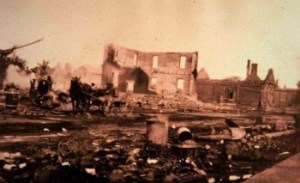
The next photo is looking southwest on Concession St. across from the intersection with Main St. This photo shows the Kenny building that contained the Bank of Hochelaga and a General store. We can see the walls of the County registry Office. The Public Library, which was between these two buildings, has burned to the ground. The hand-drawn map of the Russell Village shows the extent of the fire damage. Yellow buildings had wood cladding and the red buildings were clad in Russell brick.
While waiting for assistance from the City of Ottawa, the bucket brigades started removing household items from buildings in the wake of the fire, including furniture, appliances and personal items. It was said that many of items were hauled away by unprincipled people before the owners could claim them. Early estimates of total loss were between $75,000 and $80,000, with just over one third covered by insurance.
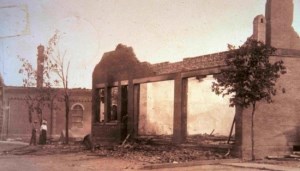
The Beginning of the Russell Fire Department
On May 18, 1915, before the Great Russell Fire, the Village of Russell Council passed a motion to purchase two large chemical fire extinguishers, each with a capacity of 60 gallons. Before the extinguishers were delivered, the Great Russell Fire had started. If not for the Silsby steam pumper from Ottawa, the whole village could have succumbed to the flames. Less than a week following the fire, the Village Council approved the purchase of the steam pumper for $850. It was at this meeting that a fire brigade was formed, with members including Donald Campbell, Fire Chief; A.H. Hope, Deputy Fire Chief; Andrew Walker, F.G. Fielding, and Rev. McLaren, Captains; A.A. Fraser, Engineer; and John Eadie, Clifford Fielding, William Shephard, Milton Walker, Firemen.
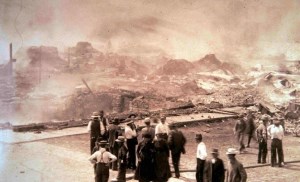
Land leased from Donald Gormley became the site for the fire hall, just east of the Concession St. Bridge. By 1919, pipes and fire hydrants were installed in the village, designed to drain water back into the river when they were not under pressure from the pumper.
The Russell County Registry Office Surviving the 1915 Fire
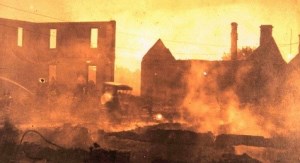
The only building that survived the great fire of 1915 was the Russell County Registry Office, located at the northwest corner of Castor St. and Concession St. At the time of the fire, all county records were safe. The double brick walls made of Russell clay brick, sand between walls, and steel doors and steel window shutters had made the building relatively fire-proof. You can see the ruins of the Stephenson house and the County Registry Office after the fire.
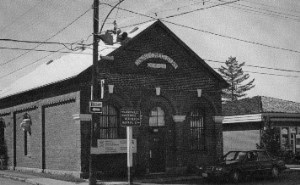
The Russell County Registry Office is the one of the oldest buildings in the village of Russell and survives to this day. The registry office has moved to the Service Ontario office in the Township of Russell building in Embrun. The old building was purchased by Kacper Waclawski made into the Russell Arts and Culture Centre.
The Little Pumper That Saved Russell
Within a few hours of arriving by the special train operated by the New York Centrail Railroad, being hitched to a team of horses and rushed to the Castor River, the little steam pumper had the raging Great Russell Fire on June 6th 1915 under control. The Silsby pumper brought from Ottawa, built in 1885 in Seneca Falls NY, was on loan from the American-Lafrance Fire Engine Company to the Ottawa Fire Department for a few months while new motorized pumpers were out for delivery. 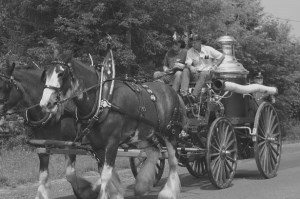
Instead of returning to Ottawa or to its American owners, the Silsby steam pumper remained in service in Russell Village until 1955, when it was condemned for failing the boiler test. The pumper sold to Wallace Barrington, who in turn sold it to Eric Dayton, owner of the Town and Country Restaurant at the corner of Carling Avenue and Richmond Road. In 1979 it was moved in front of the Marble Works on Waller Street and then to the Old Mill restaurant on the Ottawa River Parkway. By 1985 the Silsby pumper had deteriorated very badly, and the Bytown Fire Brigade purchased it to begin a 10-year restoration project. The Silsby today looks much like it would have when it left the factory in 1885 from Seneca Falls, New York.
The next photo is of the restored Silsby pumper on June 6th 2015 in the parade honouring the 100th Anniversary of the Russell Fire Department. The little pumper that saved Russell was the star of the show.
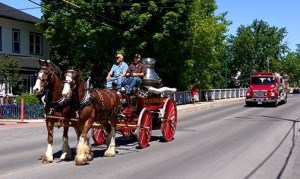
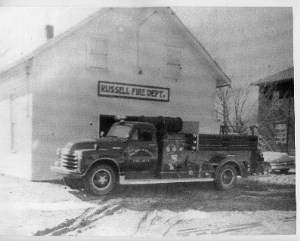
The Silsby pumper was just a steam-powered pump, and not a self-propelled full fire truck. It was eventually replaced with the first real fire truck, a 1952 GMC Maple Leaf Truck, outfitted with Bickle Seagrave equipment. The truck served the community well for 25 years.
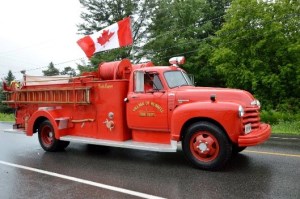
Once newer fire trucks had replaced it, it sat outside for 35 years and rusted out. Members of the Russell Historical Society restored it and it was featured in the Canada Day Parade of 2017.
Submit a Plaque Suggestion
If you know of a person, place, event or object that you think may be of historical significance to the Township of Russell, please let us know!
Disclaimer
The plaque is intended for commemorative purposes and has no legal implications. It is not a designation under the Ontario Heritage Act.
